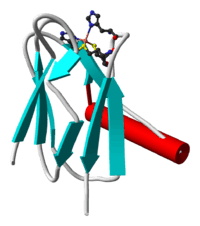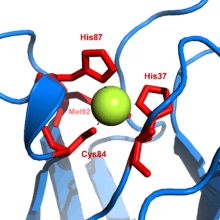Plastocyanin
Plastocyanin is a copper-containing protein that mediates electron-transfer. It is found in a variety of plants, where it participates in photosynthesis. The protein is a prototype of the blue copper proteins, a family of intensely blue-colored metalloproteins.

Function
In photosynthesis, plastocyanin functions as an electron transfer agent between cytochrome f of the cytochrome b6f complex from photosystem II and P700+ from photosystem I. Cytochrome b6f complex and P700+ are both membrane-bound proteins with exposed residues on the lumen-side of the thylakoid membrane of chloroplasts. Cytochrome f acts as an electron donor while P700+ accepts electrons from reduced plastocyanin.[1]
Structure

Plastocyanin was the first of the blue copper proteins to be characterised by X-ray crystallography.[2][1][3] It features an eight-stranded antiparallel β-barrel containing one copper center.[2]
Structures of the protein from poplar, algae, parsley, spinach, and French bean plants have been characterized crystallographically.[2] In all cases the binding site is generally conserved. Bound to the copper center are four ligands: the imidazole groups of two histidine residues (His37 and His87), the thiolate of Cys84 and the thioether of Met92. The geometry of the copper binding site is described as a ‘distorted trigonal pyramidal’. The Cu-S (cys) contact is much shorter (207 picometers) than Cu-S (met) (282 pm) bond. The elongated Cu-thioether bond appears to destabilise the CuII state thereby enhancing its oxidizing power. The blue colour (597 nm peak absorption) is assigned to a charge transfer transition from Spπ to Cudx2-y2.[4]
In the reduced form of plastocyanin, His-87 becomes protonated.
While the molecular surface of the protein near the copper binding site varies slightly, all plastocyanins have a hydrophobic surface surrounding the exposed histidine of the copper binding site. In plant plastocyanins, acidic residues are located on either side of the highly conserved tyrosine-83. Algal plastocyanins, and those from vascular plants in the family Apiaceae, contain similar acidic residues but are shaped differently from those of plant plastocyanins—they lack residues 57 and 58. In cyanobacteria, the distribution of charged residues on the surface is different from eukaryotic plastocyanins and variations among different bacterial species is large. Many cyanobacterial plastocyanins have 107 amino acids. Although the acidic patches are not conserved in bacteria, the hydrophobic patch is always present. These hydrophobic and acidic patches are believed to be the recognition/binding sites for the other proteins involved in electron transfer.
Reactions
Plastocyanin (Cu2+Pc) is reduced (an electron is added) by cytochrome f according to the following reaction:
- Cu2+Pc + e− → Cu+Pc
After dissociation, Cu+Pc diffuses through the lumen space until recognition/binding occurs with P700+, at which point P700+ oxidizes Cu+Pc according to the following reaction:
- Cu+Pc → Cu2+Pc + e−
The redox potential is about 370 mV[5] and the isoelectric pH is about 4.[6]
Entatic state
A catalyst's function is to increase the speed of the electron transfer (redox) reaction. Plastocyanin is believed to work less like an enzyme where enzymes decrease the transition energy needed to transfer the electron. Plastocyanin works more on the principles of entatic states where it increases the energy of the reactants, decreasing the amount of energy needed for the redox reaction to occur. Another was to rephrase the function of plastocyanin is that it can facilitate the electron transfer reaction by providing a small reorganization energy, which has been measured to about 16-28 kcal/mol.[7]
To study the properties of the redox reaction of plastocyanin, methods such as quantum mechanics / molecular mechanics (QM/MM) molecular dynamics simulations. This method was used to determine that plastocyanin has an entatic strain energy of about 10 kcal/mol.[7]
In the ocean
Usually, plastocyanin can be found in organisms that contain chlorophyll b and cyanobacteria, as well as algae that contain chlorophyll c. Plastocyanin has also been found in the diatom, Thalassiosira oceanica, which can be found in oceanic environments. It was surprising to find these organisms containing the protein plastocyanin because the concentration of copper dissolved in the ocean is usually low (between 0.4 – 50 nM). However, the concentration of copper in the oceans is comparatively higher compared to the concentrations of other metals such as zinc and iron. Other organisms that live in the ocean, such as phytoplankton, have adapted to where they do not need these low concentration metals (Fe and Zn) to facilitate photosynthesis and grow.[8]
References
- Redinbo MR, Yeates TO, Merchant S (February 1994). "Plastocyanin: structural and functional analysis". Journal of Bioenergetics and Biomembranes. 26 (1): 49–66. doi:10.1007/BF00763219. PMID 8027022.
- Xue Y, Okvist M, Hansson O, Young S (October 1998). "Crystal structure of spinach plastocyanin at 1.7 A resolution". Protein Science. 7 (10): 2099–105. doi:10.1002/pro.5560071006. PMC 2143848. PMID 9792096.
- Freeman HC, Guss JM (2001). "Plastocyanin". In Bode W, Messerschmidt A, Cygler M (eds.). Handbook of metalloproteins. 2. Chichester: John Wiley & Sons. pp. 1153–69. ISBN 978-0-471-62743-2.
- Gewirth AA, Solomon EI (June 1988). "Electronic structure of plastocyanin: excited state spectral features". J Am Chem Soc. 110 (12): 3811–9. doi:10.1021/ja00220a015.
- Anderson GP, Sanderson DG, Lee CH, Durell S, Anderson LB, Gross EL (December 1987). "The effect of ethylenediamine chemical modification of plastocyanin on the rate of cytochrome f oxidation and P-700+ reduction". Biochimica et Biophysica Acta (BBA) - Bioenergetics. 894 (3): 386–98. doi:10.1016/0005-2728(87)90117-4. PMID 3689779.
- Ratajczak R, Mitchell R, Haehnel W (1988). "Properties of the oxidizing site of Photosystem I". Biochim. Biophys. Acta. 933 (2): 306–318. doi:10.1016/0005-2728(88)90038-2.
- Hurd CA, Besley NA, Robinson D (June 2017). "A QM/MM study of the nature of the entatic state in plastocyanin". Journal of Computational Chemistry. 38 (16): 1431–1437. doi:10.1002/jcc.24666. PMC 5434870. PMID 27859435.
- Peers G, Price NM (May 2006). "Copper-containing plastocyanin used for electron transport by an oceanic diatom". Nature. 441 (7091): 341–4. Bibcode:2006Natur.441..341P. doi:10.1038/nature04630. PMID 16572122.
Further reading
- Berg JM, Lippard SJ (1994). "Blue Copper Proteins". Principles of bioinorganic chemistry. Sausalito, Calif: University Science Books. pp. 237–242. ISBN 978-0-935702-72-9.
- Sato K, Kohzuma T, Dennison C (February 2003). "Active-site structure and electron-transfer reactivity of plastocyanins". Journal of the American Chemical Society. 125 (8): 2101–12. doi:10.1021/ja021005u. PMID 12590538.